April 30th update:
IAU Central Bureau for Astronomical Telegrams gives the following equatorial coordinates: α = 18h 36m 56.84s δ = -28° 55′ 39.8″ (J2000.0). This places the nova 0.8° south of a line drawn between φ and δ Sagittarii, firmly in the “Teapot” asterism of the constellation Sagittarius.
Southern Hemisphere observers are certainly favoured since Sagittarius will be high in the east from 11 pm local time. Observers in the southern counties of the British Isles may glimpse it very low to the south-southeast close to 4:30 am BST before dawn twilight becomes too strong. It is noteworthy as the brightest nova seen anywhere in the sky after Nova Centauri (also discovered by John Seach) peaked at ~magnitude +3.3 in December 2013.
Indications are that PNV J18365700-2855420 is a bright classical nova of the Fe II spectral type. You can generate a detailed AAVSO finder chart by clicking here, latest magnitude estimates are here.



